正文
一直没有时间写游记,只好先拿笔记充数了。见谅。请各位多多指点。
加德满都的几天先跳过,放到和最后两天合并起来。
Twelve years before, on a visit to Nepal, I had seen those astonishing snow peaks to the north; to close that distance, to go step by step across the greatest range on earth ..., was a true pilgrimage, a journey of the heart.
--- The Snow Leopard by Peter Matthiessen
9/27/2011
Tuesday day4 Kathmandu - Nepalgunj
In the afternoon drives to the airport.
Would fly to Nepalgunj via Buddha Air. The same airline just had a crash two days ago.
Flight is delayed. We arrive at Nepalgunj in the dark. The dim light at the airport yields a sense of mystery. Mosquito/flies gather around the bulbs while porters with their face hidden in shadow are in silhouette.
Transferred to a very nice air-conditioned hotel, which is way fancier than we expected.
All traffic to Simikot is through Nepalgunj. There is no direct flight between Kathmandu and Simikot. From here the only way to get to Simikot is by air. No road to drive.
Nepalgunj is right on the border with India. At an altitude of 160m, it is humid and hot. The culture has a great Indian influence.
9/28/2011
Wednesday day5 Nepalgunj
Wake-up call at 5am. Then rushed to the airport. The luggage weight limit for each passenger is 15kg. My backpack is exactly 15kg, but my camera bag is 9kg. Have to pay the fine.
Flight to Simikot or nearby Dolpo is scheduled in the morning for the wind tends to pick up in the afternoon so it is safer to fly in the morning.
Wind speed up to 10 knots (11.5 miles/hr, 18.5 km/hr) is considered safe to fly, otherwise the strong wind would push the airplane to the mountain at landing and crash it.
A group takes off ahead of us. They were delayed from yesterday. We wait patiently for our turn but by 12:30pm the rumor comes that it is getting windy in Simikot. There is still a slim chance that we might fly out until 4pm. Chhiring sends us back to the hotel while all the luggage stay in the airport.
After a full feast of lunch, everyone is feeling a little exhausted. And the faint hope of getting to Simikot in the afternoon is axed. Sitting by the pool in the shade we decide to go to the Bazaar when the light becomes less harsh.
Visit to the Bazaar is very exciting. Four of us went. The Indian ladies decided to stay back in the hotel resting. The stores, vendors, animals...we take pictures of everything. Soon people would gather around us laughing together. It is full of life.
1. View from hotel window in the morning first day
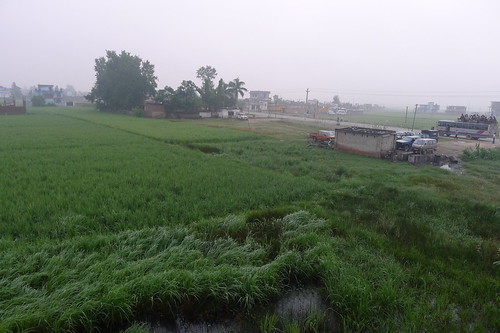
2. Barber shop at Nepalgunj Bazaar

3

4

5
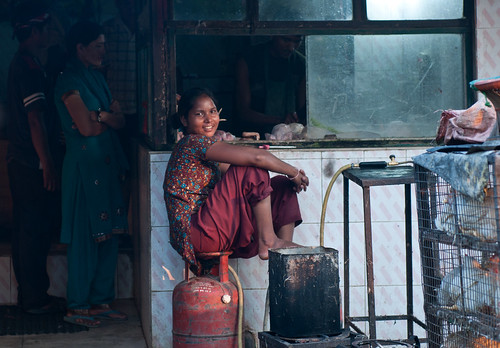
6

7
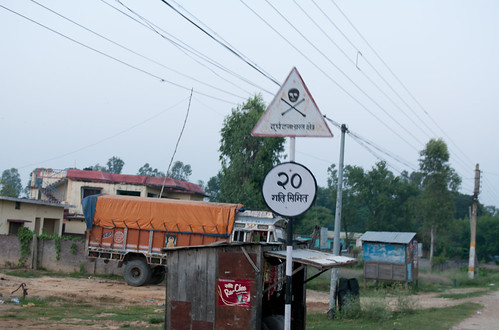
9/29/2011
Thursday day6 Nepalgunj – Simikot
Get up at 7am this time. Looking out of the window and my heart sinks. It is hazier than yesterday. I am not sure how we can fly with this kind of visibility.
Chhiring doesn’t seem to be concerned. We still go to the airport. Go through security again but luggage check-in is waived. Ladies and gentlemen go through two separate lines.
At about 9am, we are given a “go” signal!
Goma Air, a 9-seater single engine Jet will take 7 of us trekkers, our guide Chhiring, and another guide who will go with a Swiss expedition off to Simikot.
8.

Now I fully understand why visibility and wind speed are such a big deal. We literally fly through mountain passes. And the airport at Simikot is just a short stretch of track surrounded by mountains.
9

10

Simikot is located at the remote northwestern corner of Nepal at an altitude of 2822 meters. It is the capital of Humla region. Remote Humla is often called the “Hidden Himalaya”. It is a restricted area due to the consideration of preserving the pristine Tibetan culture. The security of the country is another reason.
11
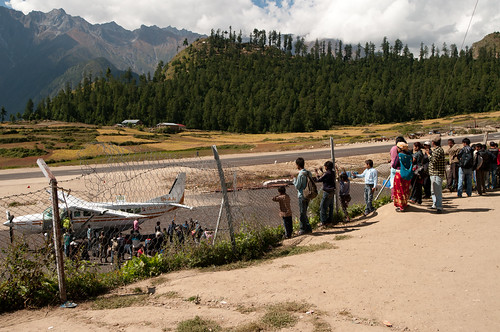
Only starting in 1993 Humla was opened. Travelers and pilgrims can now access cross-border treks to Tibet’s Mt Kailash. In order to make entry to this area, special permit must be applied and the trekking trip must be organized only through a registered trekking company.
Humla was once part of the western Tibet region known as Ngari, while Purang (普兰,Nepali name Taklakot) in present-day Tibet was once part of Nepal. For centuries, trade via Taklakot remains an important focus for traders from both sides. Traditional salt-for-grain trade is being gradually replaced by mass-produced food and consumer goods.
The route from Simikot to Taklakot is part of the Limi Valley trail. Not only is it scenically rewarding, but also culturally rich. In the lower reaches near Simikot are Hindu Thakuris and Chhetris, predictably giving way to Tibetan as we continue towards the west.
Limi Valley is 1
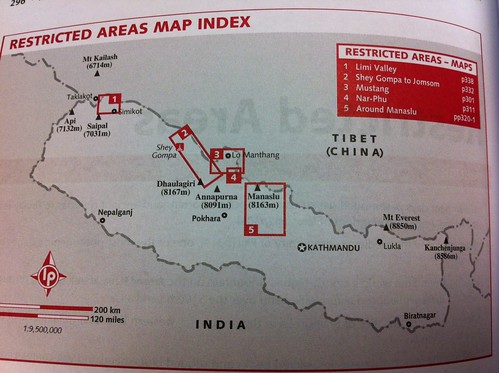
We will go along the lower portion of the Limi Valley trail to Hilsa, which is on the border with Tibet
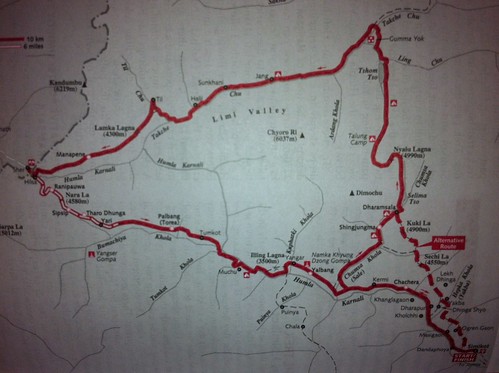
At 10:20am, we landed safely. This is it. The journey really begins.
12 Flight leaving Simikot

13

14
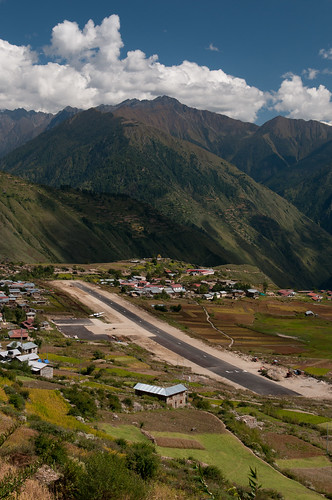
加德满都的几天先跳过,放到和最后两天合并起来。
Twelve years before, on a visit to Nepal, I had seen those astonishing snow peaks to the north; to close that distance, to go step by step across the greatest range on earth ..., was a true pilgrimage, a journey of the heart.
--- The Snow Leopard by Peter Matthiessen
9/27/2011
Tuesday day4 Kathmandu - Nepalgunj
In the afternoon drives to the airport.
Would fly to Nepalgunj via Buddha Air. The same airline just had a crash two days ago.
Flight is delayed. We arrive at Nepalgunj in the dark. The dim light at the airport yields a sense of mystery. Mosquito/flies gather around the bulbs while porters with their face hidden in shadow are in silhouette.
Transferred to a very nice air-conditioned hotel, which is way fancier than we expected.
All traffic to Simikot is through Nepalgunj. There is no direct flight between Kathmandu and Simikot. From here the only way to get to Simikot is by air. No road to drive.
Nepalgunj is right on the border with India. At an altitude of 160m, it is humid and hot. The culture has a great Indian influence.
9/28/2011
Wednesday day5 Nepalgunj
Wake-up call at 5am. Then rushed to the airport. The luggage weight limit for each passenger is 15kg. My backpack is exactly 15kg, but my camera bag is 9kg. Have to pay the fine.
Flight to Simikot or nearby Dolpo is scheduled in the morning for the wind tends to pick up in the afternoon so it is safer to fly in the morning.
Wind speed up to 10 knots (11.5 miles/hr, 18.5 km/hr) is considered safe to fly, otherwise the strong wind would push the airplane to the mountain at landing and crash it.
A group takes off ahead of us. They were delayed from yesterday. We wait patiently for our turn but by 12:30pm the rumor comes that it is getting windy in Simikot. There is still a slim chance that we might fly out until 4pm. Chhiring sends us back to the hotel while all the luggage stay in the airport.
After a full feast of lunch, everyone is feeling a little exhausted. And the faint hope of getting to Simikot in the afternoon is axed. Sitting by the pool in the shade we decide to go to the Bazaar when the light becomes less harsh.
Visit to the Bazaar is very exciting. Four of us went. The Indian ladies decided to stay back in the hotel resting. The stores, vendors, animals...we take pictures of everything. Soon people would gather around us laughing together. It is full of life.
1. View from hotel window in the morning first day

2. Barber shop at Nepalgunj Bazaar

3

4

5

6

7

9/29/2011
Thursday day6 Nepalgunj – Simikot
Get up at 7am this time. Looking out of the window and my heart sinks. It is hazier than yesterday. I am not sure how we can fly with this kind of visibility.
Chhiring doesn’t seem to be concerned. We still go to the airport. Go through security again but luggage check-in is waived. Ladies and gentlemen go through two separate lines.
At about 9am, we are given a “go” signal!
Goma Air, a 9-seater single engine Jet will take 7 of us trekkers, our guide Chhiring, and another guide who will go with a Swiss expedition off to Simikot.
8.

Now I fully understand why visibility and wind speed are such a big deal. We literally fly through mountain passes. And the airport at Simikot is just a short stretch of track surrounded by mountains.
9

10

Simikot is located at the remote northwestern corner of Nepal at an altitude of 2822 meters. It is the capital of Humla region. Remote Humla is often called the “Hidden Himalaya”. It is a restricted area due to the consideration of preserving the pristine Tibetan culture. The security of the country is another reason.
11

Only starting in 1993 Humla was opened. Travelers and pilgrims can now access cross-border treks to Tibet’s Mt Kailash. In order to make entry to this area, special permit must be applied and the trekking trip must be organized only through a registered trekking company.
Humla was once part of the western Tibet region known as Ngari, while Purang (普兰,Nepali name Taklakot) in present-day Tibet was once part of Nepal. For centuries, trade via Taklakot remains an important focus for traders from both sides. Traditional salt-for-grain trade is being gradually replaced by mass-produced food and consumer goods.
The route from Simikot to Taklakot is part of the Limi Valley trail. Not only is it scenically rewarding, but also culturally rich. In the lower reaches near Simikot are Hindu Thakuris and Chhetris, predictably giving way to Tibetan as we continue towards the west.
Limi Valley is 1

We will go along the lower portion of the Limi Valley trail to Hilsa, which is on the border with Tibet

At 10:20am, we landed safely. This is it. The journey really begins.
12 Flight leaving Simikot

13

14

评论
目前还没有任何评论
登录后才可评论.




